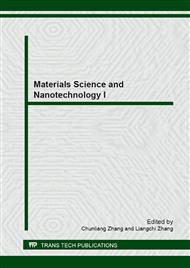[1]
J.A. Pickreil, B.V. Mokier, L.C. Griffis, Formaldehyde release rate coefficients from selected consumer products, Environ. Sci. Technol. 17 (1983) 753–757.
DOI: 10.1021/es00118a012
Google Scholar
[2]
C.A. Redlich, J. Sparer, M.R. Cullen, Sick building syndrome, Lancet 349 (1997) 1013–1016.
DOI: 10.1016/s0140-6736(96)07220-0
Google Scholar
[3]
Drury C J, Mutsaers C M J, Hart C M, et al. Low-cost all-polymer integrated circuits. Appl. Phys Lett, 1998, 73:108-110.
DOI: 10.1063/1.121783
Google Scholar
[4]
A. Perdrix, S. Parat, S. Liaudy, and A. Maitre, "Syndrome du bâtiment malsains (SBM)," Revue Franqaise des Laboratoires, vol. 2005, p.67–72, 2005.
DOI: 10.1016/s0338-9898(05)80237-9
Google Scholar
[5]
Crone B, Dodabalapur A, Gelperin A, et al. Electronic sensing of vapors with organic transistors. Appl Phys Lett, 2001.78: 2229-2232.
DOI: 10.1063/1.1360785
Google Scholar
[6]
Kelley, T. W.; Baude, P. f.; Gerlach, C.; Ender, D. E.; Muyres, D.; Haase, M. A.; Vogel, D.; Theiss, S. D. Chem. Mater. 2004, 16, 4413-4422.
DOI: 10.1021/cm049614j
Google Scholar
[7]
B. Crone, A. Dodabalapur, Y.Y. Lin, R.W. Filas, Z. Bao, A.LaDuca, R. Sarpeshkar, H.E. Katz, W. Li, Large-scale complementary integrated circuits based on organic transistors, Nature 403_2000.521–523.
DOI: 10.1038/35000530
Google Scholar
[8]
Z.-T. Zhu, T. Mason, R. Dieckmann, G.G. Malliaras, Humidity sensors based on pentacene thin-film transistors, Appl. Phys. Lett. 81 (2002) 4643–4645.
DOI: 10.1063/1.1527233
Google Scholar
[9]
H. Fukuda, K. Kasama, S. Nomura, Highly Sensitive MISFET sensors with porous Pt–SnO2 gate electrode for CO gas sensing applications, Sens. Actuators B 64 (2000) 163–168
DOI: 10.1016/s0925-4005(99)00501-8
Google Scholar
[10]
L. Torsi, A. Dodabalapur, L. Sabbatini, P.G. Zambonin, Multiparameter gas sensor based on organic thin-film transistors, Sens. Actuators B 67 (2000) 312–316.
DOI: 10.1016/s0925-4005(00)00541-4
Google Scholar
[11]
K.C. Gupta, A.G. Ulsamer, P.W. Preuss, Formaldehyde in indoor air:sources and toxicity, Environ. Int. 8 (1982) 349–358.
DOI: 10.1016/0160-4120(82)90049-6
Google Scholar
[12]
WHO, Regional Office for Europe, Air Quality Guidelines for Europe, second edition, Copenhagen, 2000.
Google Scholar
[13]
Wu W J, Yao R H, Zheng X R. A new analytical threshold voltage model for the doped polysilicon thin film transistors[J]. State Electronics,2009,53(6):607-612.
DOI: 10.1016/j.sse.2009.04.001
Google Scholar


